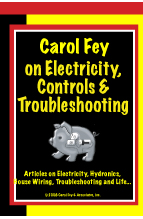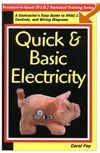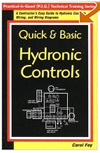by Carol Fey
Learning the basics of electricity through everyday items.A
couple times in the last year, a neighborhood kid has come to
my door looking for work.
“Er, uh, hi. My name’s Sam,” he said, looking at his over-sized
shoes. “If you need someone to, er, do your yard work, I can
do it.”
He handed me a sheet of paper. It was a nicely done flier listing
his yard- tending credentials. The flier was clearly a result
of somebody being able to use a computer.
“And, uh, you know, if you have a dog, I can walk your dog,
too.”
“Well, Sam, I don’t have a dog, and I mow the yard myself to
get the exercise. But do you do data entry?”
“Sure!” Sam looked right at me and his eyes were bright. Then
he paused, looked down, and said, “Um, what’s that?”
“Do you ever work on a computer?” I asked
“Well, yeah, sure. All the time.”
“Data entry is just keyboarding. Want me to show you?”
“Well, yeah, cool. Sure.”
I brought him into my home office to show him what I needed
to have done. I thought this was going to take awhile since
it took me agonizing months to learn the tedious process I was
going to show him. I was prepared to be very patient. I showed
him once, figuring I’d have to go through it a couple more times.
“Got it!” Sam exclaimed after the first time through. “That’s
it? Cool. Let me try it.”
And he slid himself into my place at the computer and took off
as if he’d been doing it his whole life.
Well, heck, considering he’s only about 12 or so, he has been
doing it his whole life.
When he finished and was getting ready to leave, he commented
on the electricity training boards piled on the desk near him.
“What are these things?” he asked.
“They’re for people to learn how electricity works. You probably
know all about that, right?”
“Well, um, no, not really.”
Amazing. He takes to computer stuff like the proverbial duck
to water, and he doesn’t know electricity!
Sam asked, “What are all these wires for? Don’t you just plug
something in to make it work?”
“Not quite,” I answered. “When you plug in a cord, you’re actually
plugging in two wires. Look at this,” I said, picking up a lamp
cord.
“What you see looks like only one wire. But there are two wires
inside — one to bring the electricity in to the light bulb,
and another one to take the electricity back out. Electricity
that goes in to the bulb has to have a way to get back out.”
I continued. “What you’re seeing when you look at the outside
of a lamp cord is a cable. A cable is an insulated covering
with wires inside.”
“How many wires?” Sam asked.
I answered, “For something you’re going to plug into the wall,
there is a wire inside the cable for every prong on the plug.
This lamp has a two-prong plug, so there are two wires. Have
you ever noticed that one prong is bigger than the other?”
“Er, no, I guess not,” Sam answered.
“Well it is,” I continued. “The smaller prong brings the electricity
in to the lamp. Inside the cable, that prong is connected to
the ‘hot’ wire. That’s the wire with the energy to light the
light bulb.
“The larger prong takes the electricity back out of the lamp.
It’s connected inside the cable to the ‘neutral’ or white wire.
“Now look at the edge of this lamp cord. One edge is smooth
and the other has a little slot in it going the full length
of the cord.”
“Cool,” Sam reacted.
“The slotted edge is supposed to be connected to the larger
neutral prong. The smooth edge is to be connected to the smaller
hot prong. If you replace a plug, paying attention to this detail
insures that the lamp switch controls the hot leg and no one
gets shocked.”
Sam said, “Yeah, like I’m gonna be doing that any time soon.
My mom would think I was going to kill myself.”
“Look over here at the computer cord. It has a three-prong plug.
So, there are three wires inside the computer cord.”
“Cable,” Sam corrected me.
“Good job! You’re right. The third wire is for grounding.”
“What’s that?” Sam asked.
“That’s an extra wire to take the electricity back out of the
computer — kind of like in case it gets lost, it has another
way to go home.”
Sam asked, “So back to the lamp, is the on and off switch connected
to the wires in there?”
“Exactly,” I replied. “Like I said, one end of the hot wire
is connected inside the plug to the smaller of the two prongs.
The other end of the hot wire goes to the lamp switch. Then
another piece of black wire continues from the switch to the
light bulb.
“When the light is on, that means the switch is closed. Here’s
what that’s like. Have you ever seen a drawbridge?”
“Well, yeah, on cartoons. When they have knights and horses
and stuff.”
“That’ll do. When the bridge is closed, you go across it. Same
for electricity. When the bridge or switch is open, it can’t
go across. It has to wait for the switch to be closed.
“The switch is put in the hot wire so we can keep electricity
from going into the lamp if nobody wants the light on. You don’t
want ‘hot’ electricity going to the light bulb and just hanging
out there waiting for the switch to be turned on. Someone could
get hurt.
“There’s no switch for the neutral wire because it’s just taking
the used up electricity back to where it came from. But you
must be getting tired of this. Have you had enough?”
“Naw. If I go home I’ll just have to watch my little brother.
Maybe I can use this stuff for a science project next year.
Hey, are you paying me for this part, too?”
“What makes you think you’re getting paid at all?” I said, joking.
Sam looked horrified. “Sorry, Sam, I guess that wasn’t funny.
Of course you are.” He looked considerably relieved.
I went on. “So every time we use electricity, there are three
parts that go together in what we call a circuit. There’s always
something that uses the electricity to do something. In the
lamp, of course it’s the light bulb. Then there’s always a switch,
because what good is the thing if you can’t turn it off and
on?
“And there’s where the electricity comes from. We call that
the power supply. You can just think of the power supply as
the outlet where you plug in the lamp or the computer.”
Sam asked, “What if my dad’s using his laptop on a plane? It
isn’t plugged into anything.”
“Then the power supply is the battery inside the laptop.”
“Oh, so like my iPod’s got a battery,” Sam said. “So does it
have a circuit?”
“You bet. You tell me what the parts are, like I just told you.”
Sam began. “So OK, like the battery’s the power supply. We got
that. Cool. And the thing that turns it on is the switch, right?
And, and the other part, that’s gotta be the load. What’s the
load in the iPod?”
I thought. “Well, I don’t know exactly. But it’s whatever’s
in there that makes the sound come out.”
“Oh, man, I just remembered,” Sam interrupted. “I gotta get
home ’cause I think I left my iPod out where my little brother
can get it. Oh, man, I gotta go!”
“OK, Sam, so you’ve been a little over an hour. What’s your
hourly rate?”
“Well, when I baby sit, Mom’s s’posed to pay me $5 an hour.
But this computer stuff is kinda high-tech, don’t you think,
so maybe, do you think ...”
“How about I double that for this hour then? And are you available
for more high tech data input next week?”
“Sure,” Sam said, heading out the door. “And I’ll let you pay
me to listen to more of that electricity stuff, too.” |




